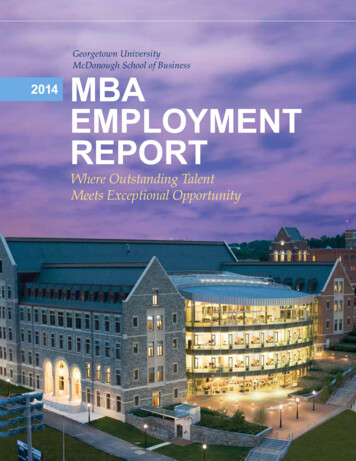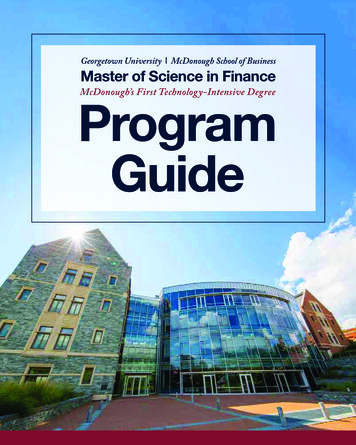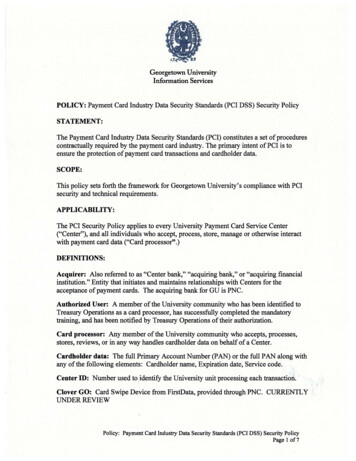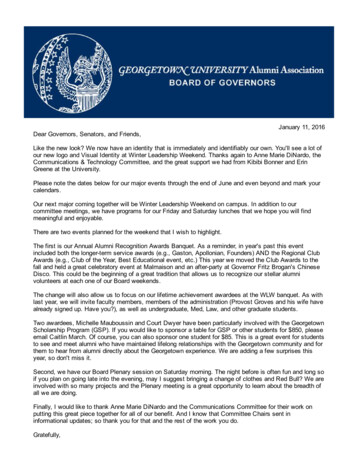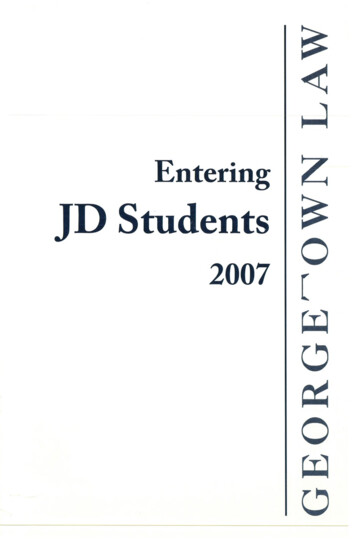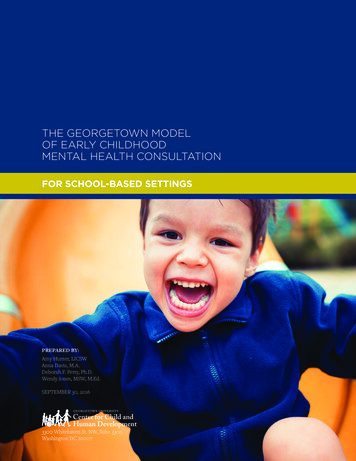
Transcription
THE GEORGETOWN MODELOF EARLY CHILDHOODMENTAL HEALTH CONSULTATIONFOR SCHOOL-BASED SETTINGSPREPARED BY:Amy Hunter, LICSWAnna Davis, M.A.Deborah F. Perry, Ph.D.Wendy Jones, MSW, M.Ed.SEPTEMBER 30, 20163300 Whitehaven St. NW, Suite 3300Washington DC 20007
ACKNOWLEDGEMENTSThis manual was developed in partnershipwith Fight For Children through a generousgrant. Our project officer Martine Gordonwas an excellent resource, linking us with ourcommunity partner and others who could supportthe sustainability and expansion of our work.We are especially grateful to the administrators,teachers, children and families at the FriendshipChamberlain Elementary School campusin Washington DC for partnering with us toimplement this model of ECMHC during schoolyears 2014-15 and 2015-16. We would also like tothank our two field reviewers, Stephen O’Connorand Renee Clemencia, who provided usefulfeedback from their respective programs in theDistrict of Columbia’s Department of BehavioralHealth and Community Counseling and MentoringServices, in Prince Georges County Maryland.Finally, this manual builds upon morethan 15 years of work that was led by RoxaneKaufmann at GUCCHD; with the first publicationof the “green book” Early Childhood Mental HealthConsultation (SAMHSA, 2000), we began a processof more fully articulating what this work looks likeand how it can benefit children, families, teachersand administrators. Thank you to Roxane for allthat she taught us and all that she gave the earlychildhood community.2The Georgetown Model of ECMHC for School-Based Settings
TABLE OF CONTENTSBackground. 5Rationale. 5Early Childhood Mental Health Consultation (ECMHC). 5What is ECMHC?. 6ECMHC Theory of Change. 7ECMHC Outcomes. 9Who does it?. 9Who is served?.11Where does it take place?. 12Types of ECMHC. 12Phases of ECMHC. 14The Georgetown University Center of Child andHuman Development (Georgetown) ECMHC Framework. 14Implementing the Georgetown ECMHC Modelin a Public Charter School in the District of Columbia. 15Quick Facts About ECMHC. 15Tips and Considerations for Entering aNew School as a Mental Health Consultant. 16Programmatic Consultation. 17Phases and Relationship Building Programmatic Consultation. 17Sample Goals in Programmatic Consultation.25Classroom Consultation. 27Phases and Relationship Building Classroom Consultation. 27Sample Goals in Classroom Consultation.34Child and Family Consultation. 35Phases and Relationship Building Child and Family Consultation. 35Sample Goals in Child and Family Consultation.44Reflective Supervision.45The Georgetown Model of ECMHC for School-Based Settings3
TABLE OF CONTENTSChallenges in Consultation. 47Key Considerations in Implementing ECMHCin a Public Charter Elementary School Setting. 51Appendices. 53A. References. 55B. Creating Practice-Based Principles for EffectiveEarly Childhood Mental Health Consultation Services.57C. Arnett Caregiver Interaction Scale.61D. Teaching Pyramid Observation Tool-Short Form.63E. Strengths and Difficulties Questionnaire.654The Georgetown Model of ECMHC for School-Based Settings
BACKGROUNDRationaleOver the last decade, significant attention has been focused on the importanceof preschool. High quality preschool has been shown to benefit children’s schoolreadiness and later life success. One of the most critical components of a highquality preschool program is its ability to promote young children’s social-emotionaldevelopment. Young children who develop a love for learning and gain skills inregulating their emotions, negotiating conflicts, following directions, focusing theirattention, and building strong friendships start with a solid foundation for success inschool and life (Raver & Knitzer, 2002).Unfortunately, many children begin preschool at a disadvantage. Despite theiryoung ages (three and four years old), some children have already had one or moreadverse experiences, such as domestic violence, community violence, child abuse,neglect, poverty, discrimination, and/or separation from caregivers. Large-scale researchhas consistently demonstrated that early-life adverse experiences have a long-term,deleterious impact on mental health, physical health, and health risk behaviors (Anda etal., 2006). Children who experience trauma have an increased likelihood of exhibitingchallenging behaviors. Many schools and teachers feel unprepared to effectively addresschildren’s challenging behaviors and to respond to children’s underlying emotionalconcerns (Hemmeter, Mialogros, & Ostrosky, 2008; Kaufmann & Wischman, 1999).When teachers and administrators are unprepared or ill-equipped to meet the needs ofchildren exposed to trauma and adverse circumstances, they may resort to suspendingor expelling these students (Gilliam, 2005).Early Childhood Mental Health Consultation (ECMHC)Indeed, to reduce or eliminate the need for suspensions and expulsions, teacherswould benefit from assistance to learn new strategies for addressing challenging. Onemodel for promoting social-emotional development, effectively addressing youngchildren’s challenging behavior, and reducing the need for preschool expulsions isEarly Childhood Mental Health Consultation (ECMHC; Hepburn, Perry, Shivers,& Gilliam, 2013). Over the last thirty years, ECMHC has been developed and evaluatedby Georgetown University’s Center for Child and Human Development (GUCCHD), incoordination with clinicians and researchers across the nation. GUCCHD has advancedthe knowledge base and expanded the implementation of ECMHC in various ways,The Georgetown Model of ECMHC for School-Based Settings5
BACKGROUNDincluding: 1) conducting research, 2) providing training and technical assistance tostates, communities, and programs implementing ECMHC, and 3) developing extensivematerials for ECMH consultants and early childhood education programs.What is ECMHC?Early Childhood Mental Health Consultation is an evidence-informed, multilevel intervention in which mental health professionals team with people who carefor young children (birth to age 6) to promote healthy social-emotional development(Cohen & Kaufmann, 2000; rev. 2005; SAMHSA, 2014). Mental health consultants withspecialized training in early childhood development form collaborative relationshipswith teachers, families, and other professionals working with young children. Theywork together to build the capacity of early childhood staff and families to addressand/or prevent challenging behaviors and to foster social-emotional competencies.Consultants do this by working alongside the early childhood professionals in theirdaily settings, sharing strategies, modeling evidence-based intervention approaches,facilitating referrals, and cultivating a deeper understanding of the factors that shapeyoung children’s social-emotional development.Consultants take a strengths-based approach to their work with providers and totheir conceptualizations of children’s behavior. Furthermore, consultants consider andintervene at multiple levels (e.g., classroom, family, school, community), understandingthe potent contextual and cultural factors impacting young children’s behavior.ECMHC programs around the country differ in their exact implementation andpractices, given that consultants tailor their activities to address the specific goals fora certain child, family, classroom, or program (Ash, Mackrain, & Johnston, 2013; Duranet al., 2009). Consultants are responsive to such factors as the population served, thevalues/mission of the program, the availability of funding, and the duration of theirrelationship with the early care and education programs.While ECMHC has been expanded into a variety of settings serving youngchildren and families (including home visiting, foster care, and homeless shelters),the most common settings are early care and education programs (Ash et al., 2013;Brinamen, Taranta, & Johnston, 2012). These include center-based community childcare and prekindergarten programs. This manual will focus on ECMHC implementationin preschool programs. Hence, the roles and contextual features of a school setting willbe highlighted. Consultees will be teachers, school administrators, and parents, and theintervention will be presented as occurring within the classroom context. It should benoted that many of the same principles presented in this manual apply across diversesetting in which ECMHC takes place. However, each setting has unique features andspecial considerations not accounted for in this manual specific to school-based settings.Nonetheless, certain activities are often used across in a variety of contextsand circumstances. Several analyses of consultants’ daily activities have identified thefollowing common tasks:6The Georgetown Model of ECMHC for School-Based Settings
BACKGROUND Conducting observations and needs assessments for children, classrooms, and centers Meetings with teachers and parents Meetings with the Director to gather pertinent information (i.e., information aboutstaff, children, families, demographics, culture, neighborhood, procedures, schoolpriorities, etc.) and to create and sustain leadership buy in for consultation services Meetings or workshops with groups of parents to increase parents’ understanding ofsocial emotional development and positive behavior guidance strategies Linking families with community resources Modeling and conducting trainings for the staff Implementing evidence-based techniques Providing prevention services to individual children Planning for sustainable changes (Kaufmann et al., 2013; Rabinovitz, 2013).The GUCCHD team—referred to moving forward as Georgetown—developed a set ofpractice-based principles that undergird ECMHC across settings. These principles werearticulated through a Delphi Process, which brought together thinking from a varietyof experts in the field (Kaufmann, et al., 2012). These principles were intended to bea starting point for discussions about fidelity to the Georgetown ECMHC Model; andthey serve as an anchor for programs and practitioners implementing ECMHC acrossthe country.PRACTICE-BASED PRINCIPLES OF ECMHC(KAUFMANN ET AL., 2012) Relationship-based Evidence-informed Collaborative Data-driven Individualized Delivered in natural settings Culturally and linguisticallyresponsive Spans the continuum frompromotion through intervention Grounded in developmentalknowledge Integrated with communityservices and supportsECMHC Theory of ChangeECMHC is based on the theory that change occurs within the context of therelationships that consultants build with teachers, families, and/or administrators.Effective consultants have mastered not only the content material, but also therelationship-building activities that best delivers it. These relationships with importantadults in the child’s life are the mediators through which consultants have an indirectimpact on the young child. Leaders in the field consider high-quality relationships tobe an essential, facilitative component of the work. It is within these relationships thatconsultants are able to collaboratively problem-solve, teach new skills, and increase thereflective capacities in child care providers.The Georgetown Model of ECMHC for School-Based Settings7
BACKGROUNDMental health consultation requires the clinician to approach their workthrough a different lens than delivering mental health treatment services. Johnstonand Brinamen (2006) articulated key tenets of this relational approach calledthe “consultative stance” (listed below). Consultants work to build a climate forconsultation where both parties actively contribute, rather than one in whichconsultants act as outside experts giving advice. Consultees are assumed to have criticalknowledge and insight about the children and their classrooms, and consultants approachtheir work with teachers with genuine curiosity about the consultees’ experiences.Expertise in consultation is thought to operate as a parallel process, throughwhich consultants model relational skills that the teachers may then use in theirinteractions with others (i.e., the children, their parents, their colleagues andsupervisors). By engaging in active inquiry, consultants model an interaction style thatvalues the subjective experiences of the other, and that is not blaming or prescriptive.Consultants “wonder” about the experiences, motivations, and contextual influencesof the child or parent, gently guiding teachers to questions their preconceived notionsand implicit biases. Throughout these potentially difficult conversations, the consultantdemonstrates empathy, acceptance, and patience. They convey respect for the teacherand demonstrate authentic interest in and curiosity about their subjective experiences.It is within these conversations, and in this warm interpersonal atmosphere, thatteachers gain fuller insight into their own role in the child’s behavior or their responseto the child, changes in perspective that they can carry forward to their work with otherchildren (Johnston & Brinamen, 2010).TENETS OF CONSULTATIVE STANCE(JOHNSTON & BRINAMEN, 2006)1.The centrality of relationships2. Parallel process as anorganizing principle3. Avoiding the positionof the expert6. Considering all levelsof influence7. Hearing and representingall voices8. Wondering instead of knowing4. Mutuality of endeavor9. Patience5. Understanding another’ssubjective experience10. Holding hopeTo support and enhance their work, consultants often receive weekly reflectivesupervision (individual, group, or both) from a supervisory clinician. In supervision,consultants can benefit from others’ experiences, and receive practical advice as wellas emotional support and validation. Supervision gives consultants access to multipleperspectives, insulates them against feelings of isolation, and provides them with amodel of authentic interest, respect, and empathy. In another form of parallel process,the supervisor models empathetic, authentic, productive relationship skills that theconsultants implement with teachers (Heller, Steier, Phillips, & Eckley, 2013).8The Georgetown Model of ECMHC for School-Based Settings
BACKGROUNDECMHC OutcomesThere is considerable evidence for the effectiveness of ECMHC in multiple stateand community studies. In reviews of the evidence, positive outcomes are seen at thechild, teacher, school, and family levels: Child Improved social-emotional competence Reduced challenging behavior Teacher Improved teacher-child relationship Decreased stress Improved classroom climate Increased teaching skills with regard to social-emotional topics School Reduced rates of suspension and expulsion Decreased teacher turnover Improved staff interactions Family Improved parent-child relationship Fewer missed work days for parentsThese outcomes are seen across ECMHC implementations across the nation,representing children, families, providers, and consultants with a variety ofdemographic backgrounds (Brennan, et al., 2008; Hepburn, Perry, Shivers and Gilliam,2013; Perry, et al., 2010; SAMHSA, 2014).Who does it?To be qualified for the position of an ECMH consultant and prepared to meetthe needs of the schools and families, consultants must have high levels of education,training, and experience. Specifically, the Georgetown ECMHC model states that amaster’s or doctoral degree in a mental health field is necessary (e.g., social work,psychology, counseling, marriage and family therapy). Additionally, consultants mustcarry an active license in their state, and have three or more years of post-master’sexperience working with young children.Consultants may be employed within a statewide ECMHC program or in atargeted (limited to a particular neighborhood or service area) ECMHC program. Thereare also ECMH consultants who work independently (privately) who are not employedby an ECMHC program.Prior to beginning ECMHC, consultants will ideally engage in core trainings(see topics below). Subsequently, they must also participate in targeted trainings asneeded to prepare for work with different populations and/or presenting concerns.The Georgetown Model of ECMHC for School-Based Settings9
BACKGROUNDThese training requirements are in addition to the continuing education requirementsmandated by licensure boards.Core Training Topics: Overview of consultation program model (e.g., philosophy and processes) Early childhood mental health (social emotional development in children birth-fiveyears old) The role of the consultant (e.g., how to approach the work, how consultation differsfrom direct therapy).Training methods may include a standardized curriculum, pre-service and in-servicetrainings, mentoring and/or shadowing opportunities with a senior consultant, and/orongoing professional development opportunities. GUCCHD developed a series of on-linetutorials for ECMHC as part of an Innovation and Improvement Program grant from theOffice of Head Start. They can be found at: http://www.ecmhc.org/tutorials/index.html.In addition to the objective qualifications for consultants, there are alsocompetencies that describe the necessary knowledge, skills, and abilities of effectiveconsultants, detailed below. Competencies for ECMH consultants can be found on theHead Start Early Childhood Learning and Knowledge Center (ECLKC) at consultation-tool as well as on the Substance Abuse and Mental Health ServicesAdministration’s (SAMHSA) National Center of Excellence for Infant and EarlyChildhood Mental Health website http://www.samhsa.gov/iecmhc. The competenciesare divided into eight core areas and are summarized below and support work in bothearly care and education as well as home visiting programs.IECMHC COMPETENCIES AT A GLANCE (Center of Excellence for IECMHC)CATEGORIES10SUMMARY OF SKILLSRole of theIECMH ConsultantUnderstands and can convey how IECMHC is a mental healthspecialization that is distinct from other activities in which mentalhealth professionals may engage. Demonstrates an ability tostrengthen families’ and early childhood education/home visiting(ECE/HV) staff’s capacities to support the social-emotional wellbeing and relational health of children and families in a range ofsettings. Partners with such adults in working to prevent mentalhealth problems from developing or increasing in intensity and/or in responding effectively when mental health concerns alreadyexistFoundationalKnowledgeDraws from diverse domains of knowledge to understandchildren, families, and ECE/HV staff and how they relate to eachother. Turns to a variety of disciplines and theories to inform thedirection that consultation takes and the decisions that emergefrom its unfolding process.The Georgetown Model of ECMHC for School-Based Settings
BACKGROUNDIECMHC COMPETENCIES AT A GLANCE (Center of Excellence for IECMHC)CATEGORIESSUMMARY OF SKILLSEquity and CulturalSensitivityDescribes and demonstrates how culture (beliefs, values,attitudes, biases, and experiences) shapes relationships andbehaviors, and how it influences settings and communities inimportant and meaningful ways.Reflective PracticeThinks about and questions personal influences and actionsbefore, during, or after consultative interactions. Considers theinfluences on and perspectives of others (e.g., child/family/staff)in the context of consultation, i.e., “What must this experiencehave been like for the child staff parent?” Promotes reflectivepractice in consultees, using this experience-based learning tosupport consultees’ professional growth and development.Specific Child- andFamily-FocusedConsultationCollaborates with families and/or ECE/HV staff to understand andrespond effectively to a child’s or parent’s mental health needs,behavioral difficulties, and/or developmental challenges. Partnersrespectfully with families and ECE/HV staff to understand thecontext and nature of a particular family’s life in order to enhancechild and family well-beingGeneral Classroom Collaborates with families and ECE/HV staff in the effort toand Home-Focused promote warm and trusting relationships, steady routines,Consultationand development-enhancing interactions that positivelyimpact classroom and home climates. Explores how elementsof classroom and/or family life can play a powerful role insupporting all children’s social-emotional development.ProgrammaticConsultationMaintains a systemic approach and aims for program-wideimpact through a focus on multiple issues that affect the overallquality of an ECE/HV setting. Works to enhance programmaticfunctioning by assisting ECE/HV program administrators and/or staff to consider the setting’s overall social-emotional climateand to solve issues that affect more than one child, staff member,and/or family.SystemicOrientationWorks within and across systems, integrating mental healthconcepts and supports into the cultures and environments whereyoung children spend time. Maintains awareness of the systemswithin which IECMHC occurs and considers these contexts whenseeking to understand factors that promote or hinder the processof change.Who is served?ECMHC is an indirect intervention in which consultants work with teachers,parents, and administrators to build their capacities to promote healthy socioemotionaldevelopment and to address challenging behaviors. Hence, the vast majority ofconsultants’ time is spent with adults on behalf of young children. Often, consultationis sought when children demonstrate challenging behaviors. ECMHC may directlyenhance adults’ abilities to foster children’s emotional and relational well-being. Inturn, young children’s behavior and self-regulation may improve.The Georgetown Model of ECMHC for School-Based Settings11
BACKGROUNDChildren are most commonly referred for consultation when they demonstrateexternalizing behaviors, such as aggression, defiant behavior, or hyperactivity/inattention.Because children from low-income backgrounds are more likely to experience earlyadversity and to demonstrate subsequent behavioral manifestations of trauma, referralsare more likely from communities with fewer resources. While ECMHC may servechildren ages 0-6, preschoolers are referred at higher rates than infants and toddlers. AsECMHC programs mature, there is often an increased recognition of socioemotionalconcerns in infant and toddlers, as well as improved identification of internalizingbehaviors, such as attachment issues and anxiety (Perry, personal communication).Where does it take place?While mental health consultation can be embedded within a variety of settingsserving young children and their families, the majority of ECMHC evaluations havebeen conducted in early care and education (ECE) settings. In terms of ECE settings,ECMHC has been implemented in day care, child development centers, and homebased care. It has also been implemented in private, public, and charter prekindergartenclassrooms. Consultation may also be incorporated into existing home visiting protocolsas an additional support. ECMHC can be incorporated into many other settings inwhich adults interact with young children, including kith and kin care, primary care,foster care, and homeless shelters (Ash et al, 2013; Brinamen & Johnston, 2012).In a given setting, the length and frequency of consultation may vary. A tentativeschedule is often established from the initiation of consultation, although it may beadjusted based on the evolving needs of the teachers and administrators. Most commonly,consultation occurs weekly. However, more intensive consultation may involvemultiple visits per week, and less frequent consultation (e.g., biweekly visits) may beseen particularly in rural areas. Consultants may provide a partial or full day of servicesat each site. A consultant may work at a site for a specific, predetermined length of time(e.g., 6 months), or may work at a site until needs have been met (Duran et al., 2009).Types of ECMHCThere are three subtypes of ECMHC which are distinguished by particular goals.Specifically, there is: 1) programmatic consultation, 2) classroom consultation, and3) child and family consultation. Programmatic consultation refers to collaborationbetween the consultant and the school administrators to work to ensure that schoolpolicies and procedures optimally support child socioemotional development andfacilitate a positive school climate. Topics discussed in programmatic consultationmay include disciplinary policies, effective communication among staff members,and professional development opportunities. In classroom consultation, consultants’work to enhance the capabilities of teachers and thereby benefit the children in theirclassrooms. For example, consultants may work with teachers to incorporate positivebehavior supports into everyday classroom activities, or to reflect upon and alter12The Georgetown Model of ECMHC for School-Based Settings
BACKGROUNDtransition procedures. In child and family consultation, consultants work with teachersand parents in support of a child with challenging behavior. They may help teachersand parents to promote positive behaviors and/or deescalate problems to preventsuspensions and expulsions.In a given setting, a consultant often engages in two or all three types of consultation.A specific goal may be best addressed through intervening on multiple levels, or the sitemay have multiple goals for consultation. Notably, the distinctions among these types ofconsultation have become somewhat less relevant because, from a relational perspective,child-focused, teacher-focused, and program-focused work often blend together.ProgrammaticClassroomChild and FamilyDefinition: Consultant worksin collaboration with programleadership to assess and addressissues related to a program’sstructure, policies, procedures,professional development,philosophy, mission, and approachas they relate to supporting themental health of young childrenand their families.Definition: Consultation to teachersabout the overall approach tosupporting young children socialemotional development andeffectively addressing youngchildren’s challenging behavior.Classroom consultation focuseson issues that impact more thanone child or family. In classroomconsultation the consultant and theteachers may explore a variety ofissues including, but, not limited to:teachers’ approach with children;teachers’ relationships with eachother; teachers’ ideas about disciplineand be
BACKGROUND The Georgetown Model of ECMHC for School-Based Settings 7 Conducting obse rvations and needs assessments for children, classrooms, and centers Meetings with teachers and parents Meetings with the Director to gather pertinent information (i.e., information about staff, children, families, demographics, culture, neighborhood, procedures, school




